Comparative Study of Franchising Model and E-commerce Business Models
VerifiedAdded on 2022/10/12
|25
|5696
|17
Report
AI Summary
This report undertakes a comparative analysis of the franchise model and the e-commerce business model, aiming to determine which is more effective. The introduction provides background information, definitions, and research questions. The literature review explores relevant concepts, theories, and models related to both franchising and e-commerce, examining their relationships from various scholarly perspectives. The methodology section details the research methods used, including a positivism philosophy, a deductive approach, a descriptive design, secondary data, qualitative research, and thematic analysis. The findings reveal differences in operational structure and revenue generation between the two models, with e-commerce emphasizing online presence and franchising utilizing brand name sales. The report analyzes the growth trends of both models, considering factors such as changing consumer behavior and economic conditions. The report concludes with limitations, and recommendations for further research.
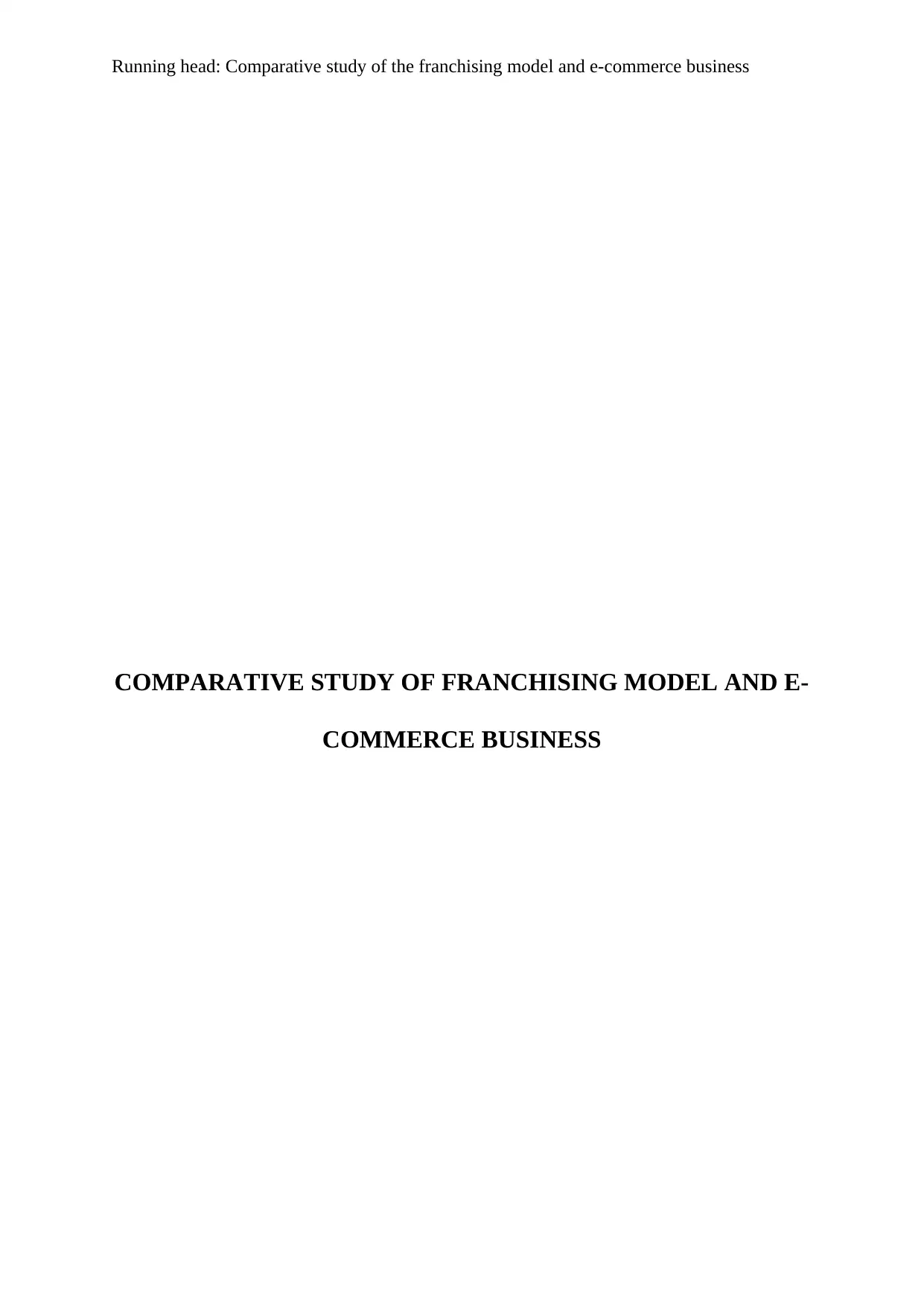
Running head: Comparative study of the franchising model and e-commerce business
COMPARATIVE STUDY OF FRANCHISING MODEL AND E-
COMMERCE BUSINESS
COMPARATIVE STUDY OF FRANCHISING MODEL AND E-
COMMERCE BUSINESS
Paraphrase This Document
Need a fresh take? Get an instant paraphrase of this document with our AI Paraphraser
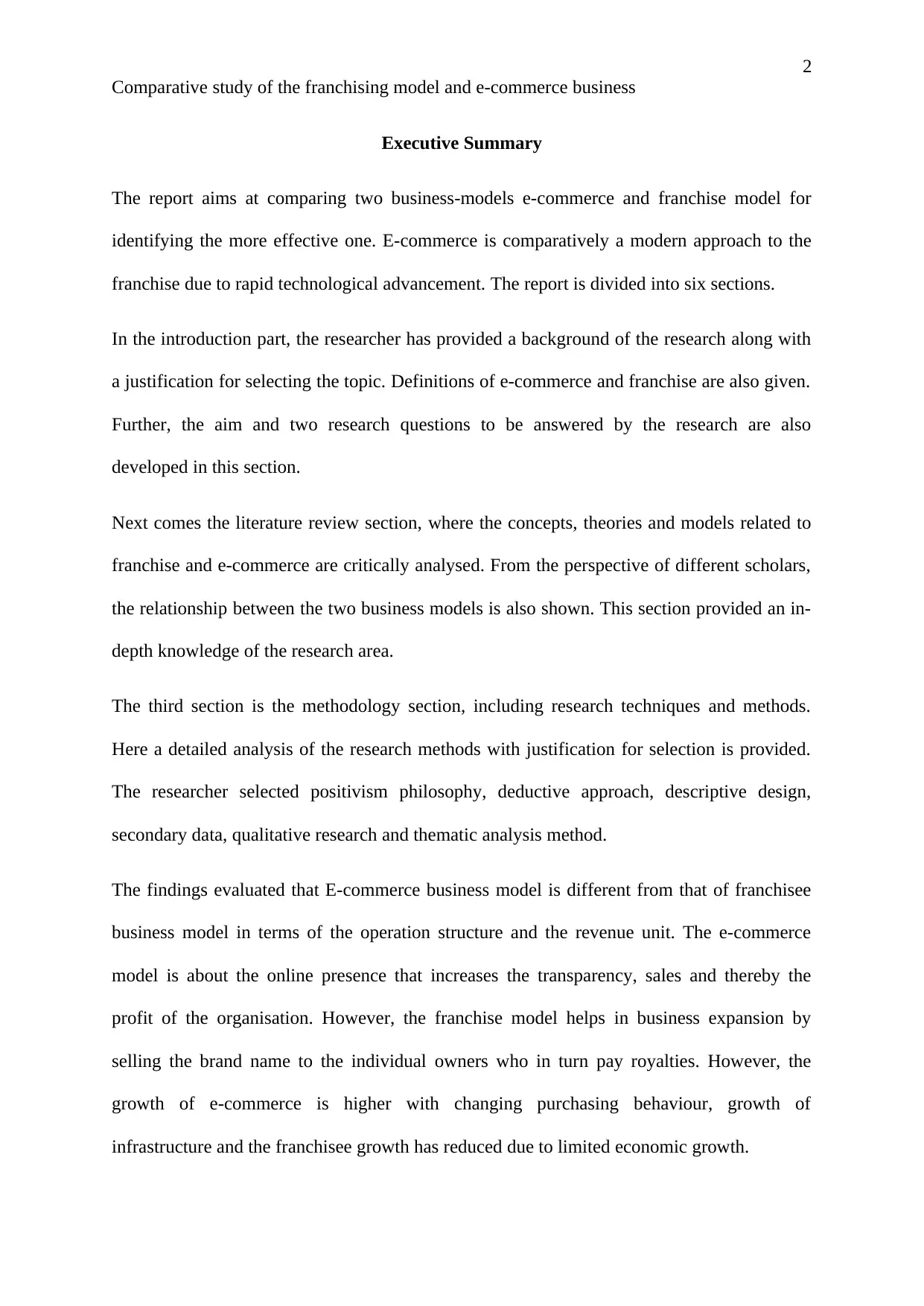
2
Comparative study of the franchising model and e-commerce business
Executive Summary
The report aims at comparing two business-models e-commerce and franchise model for
identifying the more effective one. E-commerce is comparatively a modern approach to the
franchise due to rapid technological advancement. The report is divided into six sections.
In the introduction part, the researcher has provided a background of the research along with
a justification for selecting the topic. Definitions of e-commerce and franchise are also given.
Further, the aim and two research questions to be answered by the research are also
developed in this section.
Next comes the literature review section, where the concepts, theories and models related to
franchise and e-commerce are critically analysed. From the perspective of different scholars,
the relationship between the two business models is also shown. This section provided an in-
depth knowledge of the research area.
The third section is the methodology section, including research techniques and methods.
Here a detailed analysis of the research methods with justification for selection is provided.
The researcher selected positivism philosophy, deductive approach, descriptive design,
secondary data, qualitative research and thematic analysis method.
The findings evaluated that E-commerce business model is different from that of franchisee
business model in terms of the operation structure and the revenue unit. The e-commerce
model is about the online presence that increases the transparency, sales and thereby the
profit of the organisation. However, the franchise model helps in business expansion by
selling the brand name to the individual owners who in turn pay royalties. However, the
growth of e-commerce is higher with changing purchasing behaviour, growth of
infrastructure and the franchisee growth has reduced due to limited economic growth.
Comparative study of the franchising model and e-commerce business
Executive Summary
The report aims at comparing two business-models e-commerce and franchise model for
identifying the more effective one. E-commerce is comparatively a modern approach to the
franchise due to rapid technological advancement. The report is divided into six sections.
In the introduction part, the researcher has provided a background of the research along with
a justification for selecting the topic. Definitions of e-commerce and franchise are also given.
Further, the aim and two research questions to be answered by the research are also
developed in this section.
Next comes the literature review section, where the concepts, theories and models related to
franchise and e-commerce are critically analysed. From the perspective of different scholars,
the relationship between the two business models is also shown. This section provided an in-
depth knowledge of the research area.
The third section is the methodology section, including research techniques and methods.
Here a detailed analysis of the research methods with justification for selection is provided.
The researcher selected positivism philosophy, deductive approach, descriptive design,
secondary data, qualitative research and thematic analysis method.
The findings evaluated that E-commerce business model is different from that of franchisee
business model in terms of the operation structure and the revenue unit. The e-commerce
model is about the online presence that increases the transparency, sales and thereby the
profit of the organisation. However, the franchise model helps in business expansion by
selling the brand name to the individual owners who in turn pay royalties. However, the
growth of e-commerce is higher with changing purchasing behaviour, growth of
infrastructure and the franchisee growth has reduced due to limited economic growth.
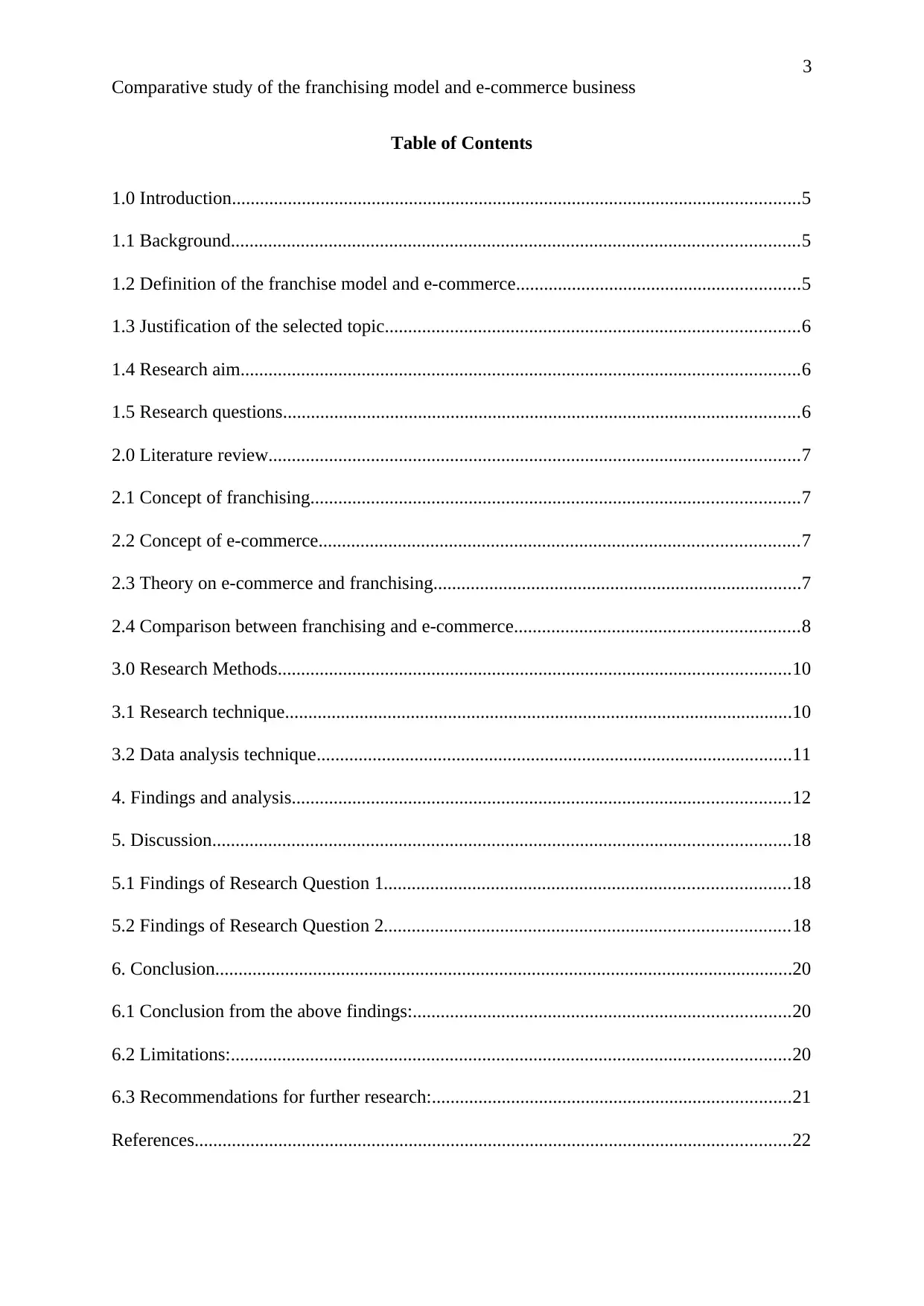
3
Comparative study of the franchising model and e-commerce business
Table of Contents
1.0 Introduction..........................................................................................................................5
1.1 Background..........................................................................................................................5
1.2 Definition of the franchise model and e-commerce.............................................................5
1.3 Justification of the selected topic.........................................................................................6
1.4 Research aim........................................................................................................................6
1.5 Research questions...............................................................................................................6
2.0 Literature review..................................................................................................................7
2.1 Concept of franchising.........................................................................................................7
2.2 Concept of e-commerce.......................................................................................................7
2.3 Theory on e-commerce and franchising...............................................................................7
2.4 Comparison between franchising and e-commerce.............................................................8
3.0 Research Methods..............................................................................................................10
3.1 Research technique.............................................................................................................10
3.2 Data analysis technique......................................................................................................11
4. Findings and analysis...........................................................................................................12
5. Discussion............................................................................................................................18
5.1 Findings of Research Question 1.......................................................................................18
5.2 Findings of Research Question 2.......................................................................................18
6. Conclusion............................................................................................................................20
6.1 Conclusion from the above findings:.................................................................................20
6.2 Limitations:........................................................................................................................20
6.3 Recommendations for further research:.............................................................................21
References................................................................................................................................22
Comparative study of the franchising model and e-commerce business
Table of Contents
1.0 Introduction..........................................................................................................................5
1.1 Background..........................................................................................................................5
1.2 Definition of the franchise model and e-commerce.............................................................5
1.3 Justification of the selected topic.........................................................................................6
1.4 Research aim........................................................................................................................6
1.5 Research questions...............................................................................................................6
2.0 Literature review..................................................................................................................7
2.1 Concept of franchising.........................................................................................................7
2.2 Concept of e-commerce.......................................................................................................7
2.3 Theory on e-commerce and franchising...............................................................................7
2.4 Comparison between franchising and e-commerce.............................................................8
3.0 Research Methods..............................................................................................................10
3.1 Research technique.............................................................................................................10
3.2 Data analysis technique......................................................................................................11
4. Findings and analysis...........................................................................................................12
5. Discussion............................................................................................................................18
5.1 Findings of Research Question 1.......................................................................................18
5.2 Findings of Research Question 2.......................................................................................18
6. Conclusion............................................................................................................................20
6.1 Conclusion from the above findings:.................................................................................20
6.2 Limitations:........................................................................................................................20
6.3 Recommendations for further research:.............................................................................21
References................................................................................................................................22
⊘ This is a preview!⊘
Do you want full access?
Subscribe today to unlock all pages.

Trusted by 1+ million students worldwide
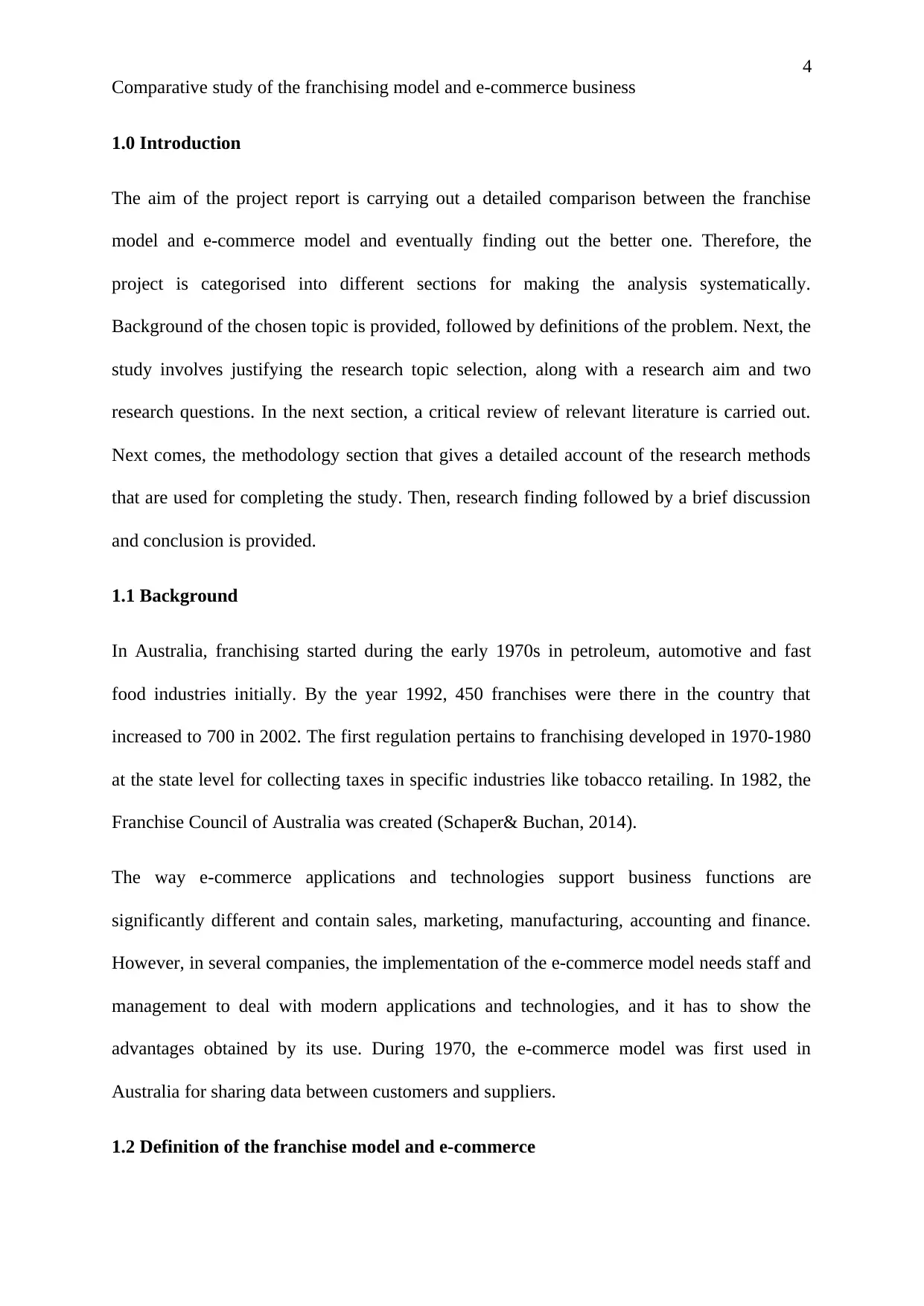
4
Comparative study of the franchising model and e-commerce business
1.0 Introduction
The aim of the project report is carrying out a detailed comparison between the franchise
model and e-commerce model and eventually finding out the better one. Therefore, the
project is categorised into different sections for making the analysis systematically.
Background of the chosen topic is provided, followed by definitions of the problem. Next, the
study involves justifying the research topic selection, along with a research aim and two
research questions. In the next section, a critical review of relevant literature is carried out.
Next comes, the methodology section that gives a detailed account of the research methods
that are used for completing the study. Then, research finding followed by a brief discussion
and conclusion is provided.
1.1 Background
In Australia, franchising started during the early 1970s in petroleum, automotive and fast
food industries initially. By the year 1992, 450 franchises were there in the country that
increased to 700 in 2002. The first regulation pertains to franchising developed in 1970-1980
at the state level for collecting taxes in specific industries like tobacco retailing. In 1982, the
Franchise Council of Australia was created (Schaper& Buchan, 2014).
The way e-commerce applications and technologies support business functions are
significantly different and contain sales, marketing, manufacturing, accounting and finance.
However, in several companies, the implementation of the e-commerce model needs staff and
management to deal with modern applications and technologies, and it has to show the
advantages obtained by its use. During 1970, the e-commerce model was first used in
Australia for sharing data between customers and suppliers.
1.2 Definition of the franchise model and e-commerce
Comparative study of the franchising model and e-commerce business
1.0 Introduction
The aim of the project report is carrying out a detailed comparison between the franchise
model and e-commerce model and eventually finding out the better one. Therefore, the
project is categorised into different sections for making the analysis systematically.
Background of the chosen topic is provided, followed by definitions of the problem. Next, the
study involves justifying the research topic selection, along with a research aim and two
research questions. In the next section, a critical review of relevant literature is carried out.
Next comes, the methodology section that gives a detailed account of the research methods
that are used for completing the study. Then, research finding followed by a brief discussion
and conclusion is provided.
1.1 Background
In Australia, franchising started during the early 1970s in petroleum, automotive and fast
food industries initially. By the year 1992, 450 franchises were there in the country that
increased to 700 in 2002. The first regulation pertains to franchising developed in 1970-1980
at the state level for collecting taxes in specific industries like tobacco retailing. In 1982, the
Franchise Council of Australia was created (Schaper& Buchan, 2014).
The way e-commerce applications and technologies support business functions are
significantly different and contain sales, marketing, manufacturing, accounting and finance.
However, in several companies, the implementation of the e-commerce model needs staff and
management to deal with modern applications and technologies, and it has to show the
advantages obtained by its use. During 1970, the e-commerce model was first used in
Australia for sharing data between customers and suppliers.
1.2 Definition of the franchise model and e-commerce
Paraphrase This Document
Need a fresh take? Get an instant paraphrase of this document with our AI Paraphraser
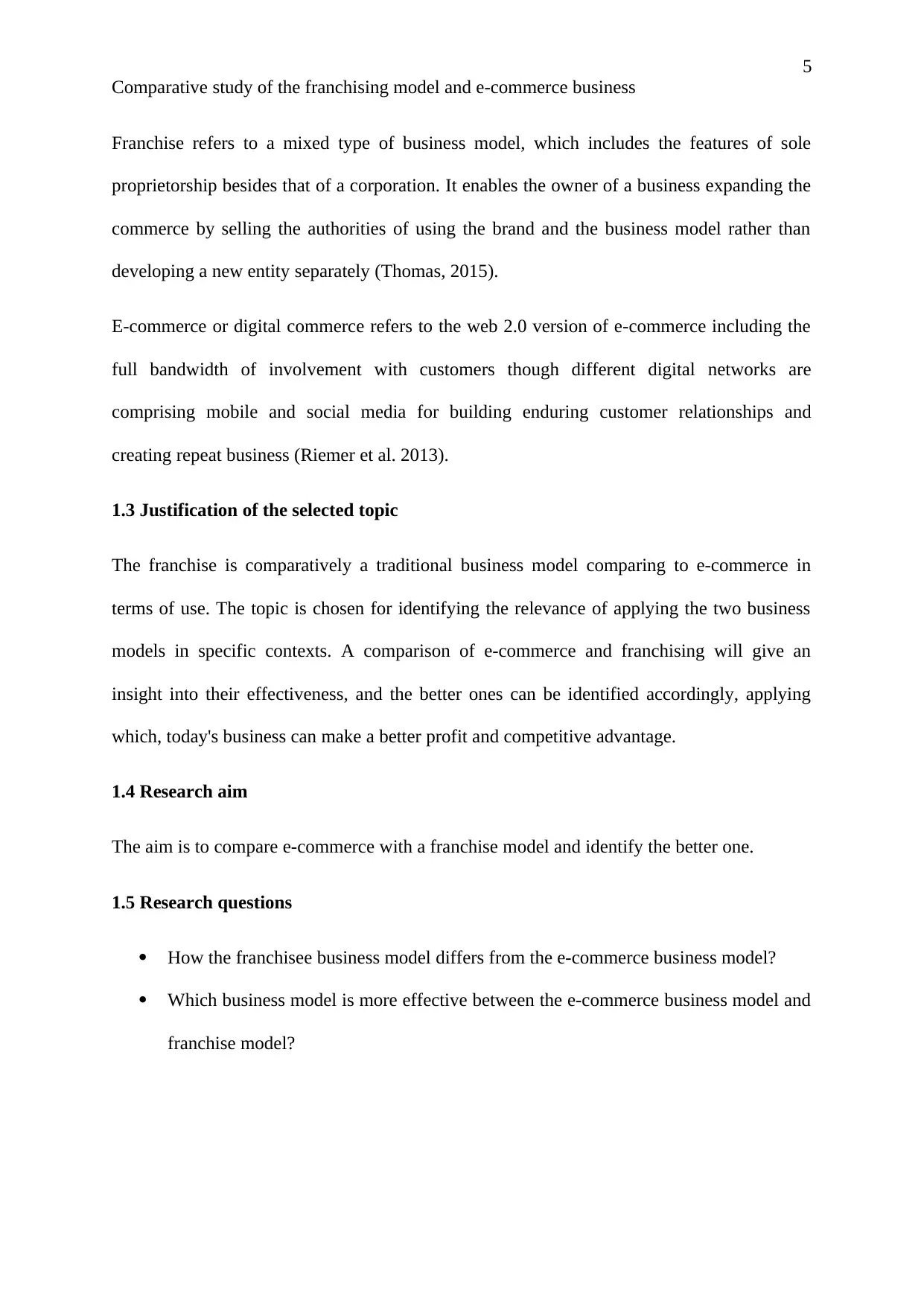
5
Comparative study of the franchising model and e-commerce business
Franchise refers to a mixed type of business model, which includes the features of sole
proprietorship besides that of a corporation. It enables the owner of a business expanding the
commerce by selling the authorities of using the brand and the business model rather than
developing a new entity separately (Thomas, 2015).
E-commerce or digital commerce refers to the web 2.0 version of e-commerce including the
full bandwidth of involvement with customers though different digital networks are
comprising mobile and social media for building enduring customer relationships and
creating repeat business (Riemer et al. 2013).
1.3 Justification of the selected topic
The franchise is comparatively a traditional business model comparing to e-commerce in
terms of use. The topic is chosen for identifying the relevance of applying the two business
models in specific contexts. A comparison of e-commerce and franchising will give an
insight into their effectiveness, and the better ones can be identified accordingly, applying
which, today's business can make a better profit and competitive advantage.
1.4 Research aim
The aim is to compare e-commerce with a franchise model and identify the better one.
1.5 Research questions
How the franchisee business model differs from the e-commerce business model?
Which business model is more effective between the e-commerce business model and
franchise model?
Comparative study of the franchising model and e-commerce business
Franchise refers to a mixed type of business model, which includes the features of sole
proprietorship besides that of a corporation. It enables the owner of a business expanding the
commerce by selling the authorities of using the brand and the business model rather than
developing a new entity separately (Thomas, 2015).
E-commerce or digital commerce refers to the web 2.0 version of e-commerce including the
full bandwidth of involvement with customers though different digital networks are
comprising mobile and social media for building enduring customer relationships and
creating repeat business (Riemer et al. 2013).
1.3 Justification of the selected topic
The franchise is comparatively a traditional business model comparing to e-commerce in
terms of use. The topic is chosen for identifying the relevance of applying the two business
models in specific contexts. A comparison of e-commerce and franchising will give an
insight into their effectiveness, and the better ones can be identified accordingly, applying
which, today's business can make a better profit and competitive advantage.
1.4 Research aim
The aim is to compare e-commerce with a franchise model and identify the better one.
1.5 Research questions
How the franchisee business model differs from the e-commerce business model?
Which business model is more effective between the e-commerce business model and
franchise model?
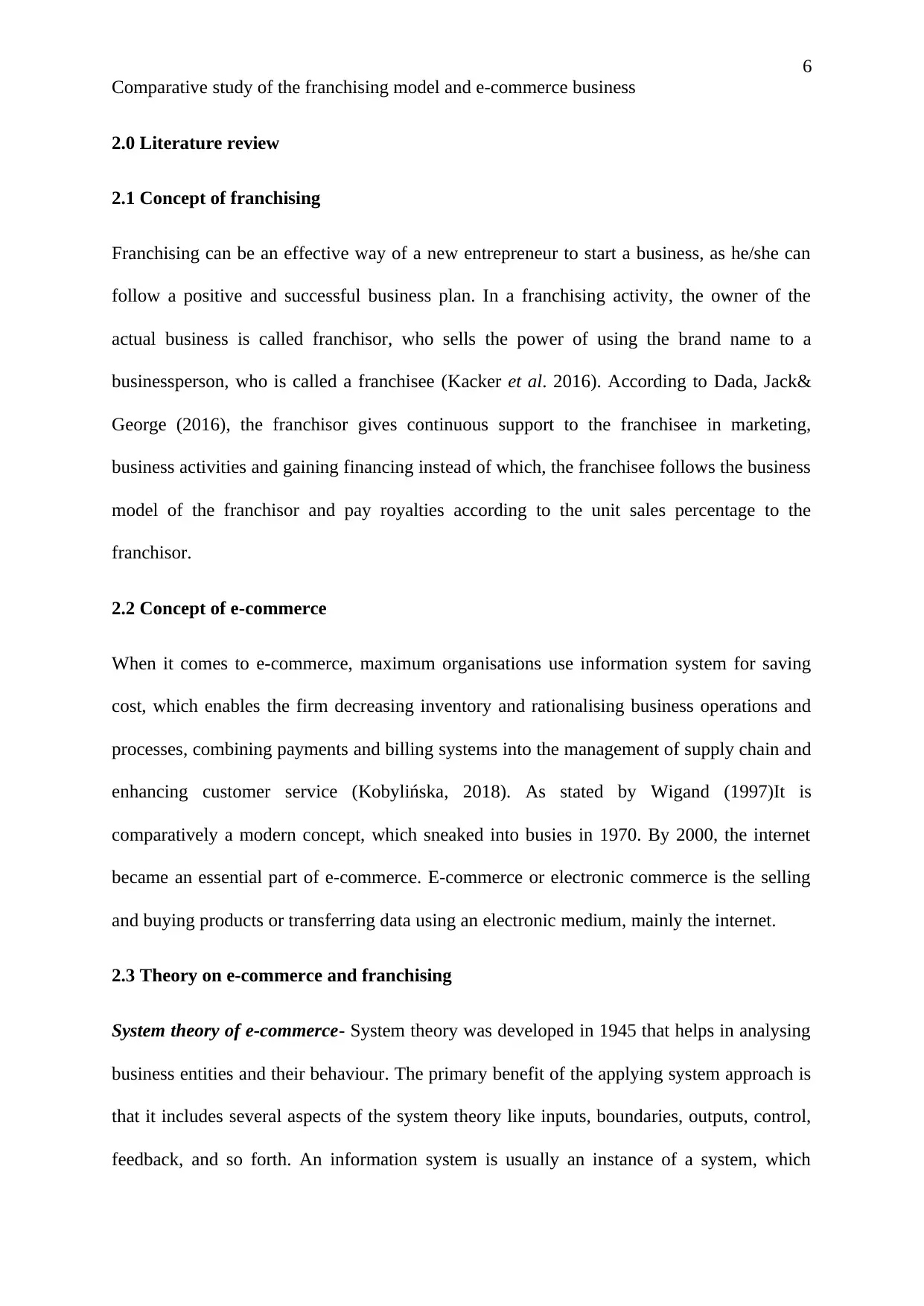
6
Comparative study of the franchising model and e-commerce business
2.0 Literature review
2.1 Concept of franchising
Franchising can be an effective way of a new entrepreneur to start a business, as he/she can
follow a positive and successful business plan. In a franchising activity, the owner of the
actual business is called franchisor, who sells the power of using the brand name to a
businessperson, who is called a franchisee (Kacker et al. 2016). According to Dada, Jack&
George (2016), the franchisor gives continuous support to the franchisee in marketing,
business activities and gaining financing instead of which, the franchisee follows the business
model of the franchisor and pay royalties according to the unit sales percentage to the
franchisor.
2.2 Concept of e-commerce
When it comes to e-commerce, maximum organisations use information system for saving
cost, which enables the firm decreasing inventory and rationalising business operations and
processes, combining payments and billing systems into the management of supply chain and
enhancing customer service (Kobylińska, 2018). As stated by Wigand (1997)It is
comparatively a modern concept, which sneaked into busies in 1970. By 2000, the internet
became an essential part of e-commerce. E-commerce or electronic commerce is the selling
and buying products or transferring data using an electronic medium, mainly the internet.
2.3 Theory on e-commerce and franchising
System theory of e-commerce- System theory was developed in 1945 that helps in analysing
business entities and their behaviour. The primary benefit of the applying system approach is
that it includes several aspects of the system theory like inputs, boundaries, outputs, control,
feedback, and so forth. An information system is usually an instance of a system, which
Comparative study of the franchising model and e-commerce business
2.0 Literature review
2.1 Concept of franchising
Franchising can be an effective way of a new entrepreneur to start a business, as he/she can
follow a positive and successful business plan. In a franchising activity, the owner of the
actual business is called franchisor, who sells the power of using the brand name to a
businessperson, who is called a franchisee (Kacker et al. 2016). According to Dada, Jack&
George (2016), the franchisor gives continuous support to the franchisee in marketing,
business activities and gaining financing instead of which, the franchisee follows the business
model of the franchisor and pay royalties according to the unit sales percentage to the
franchisor.
2.2 Concept of e-commerce
When it comes to e-commerce, maximum organisations use information system for saving
cost, which enables the firm decreasing inventory and rationalising business operations and
processes, combining payments and billing systems into the management of supply chain and
enhancing customer service (Kobylińska, 2018). As stated by Wigand (1997)It is
comparatively a modern concept, which sneaked into busies in 1970. By 2000, the internet
became an essential part of e-commerce. E-commerce or electronic commerce is the selling
and buying products or transferring data using an electronic medium, mainly the internet.
2.3 Theory on e-commerce and franchising
System theory of e-commerce- System theory was developed in 1945 that helps in analysing
business entities and their behaviour. The primary benefit of the applying system approach is
that it includes several aspects of the system theory like inputs, boundaries, outputs, control,
feedback, and so forth. An information system is usually an instance of a system, which
⊘ This is a preview!⊘
Do you want full access?
Subscribe today to unlock all pages.

Trusted by 1+ million students worldwide
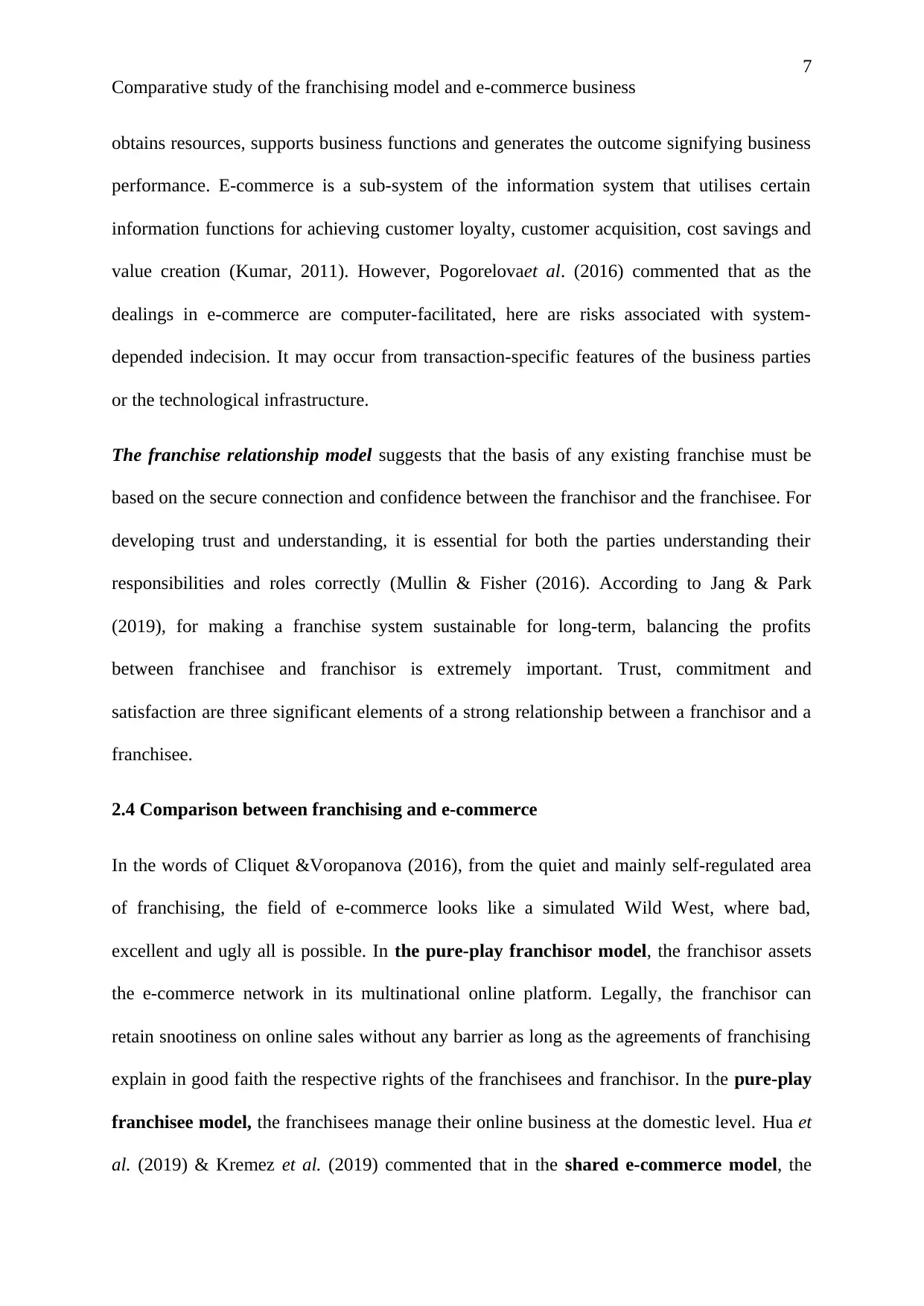
7
Comparative study of the franchising model and e-commerce business
obtains resources, supports business functions and generates the outcome signifying business
performance. E-commerce is a sub-system of the information system that utilises certain
information functions for achieving customer loyalty, customer acquisition, cost savings and
value creation (Kumar, 2011). However, Pogorelovaet al. (2016) commented that as the
dealings in e-commerce are computer-facilitated, here are risks associated with system-
depended indecision. It may occur from transaction-specific features of the business parties
or the technological infrastructure.
The franchise relationship model suggests that the basis of any existing franchise must be
based on the secure connection and confidence between the franchisor and the franchisee. For
developing trust and understanding, it is essential for both the parties understanding their
responsibilities and roles correctly (Mullin & Fisher (2016). According to Jang & Park
(2019), for making a franchise system sustainable for long-term, balancing the profits
between franchisee and franchisor is extremely important. Trust, commitment and
satisfaction are three significant elements of a strong relationship between a franchisor and a
franchisee.
2.4 Comparison between franchising and e-commerce
In the words of Cliquet &Voropanova (2016), from the quiet and mainly self-regulated area
of franchising, the field of e-commerce looks like a simulated Wild West, where bad,
excellent and ugly all is possible. In the pure-play franchisor model, the franchisor assets
the e-commerce network in its multinational online platform. Legally, the franchisor can
retain snootiness on online sales without any barrier as long as the agreements of franchising
explain in good faith the respective rights of the franchisees and franchisor. In the pure-play
franchisee model, the franchisees manage their online business at the domestic level. Hua et
al. (2019) & Kremez et al. (2019) commented that in the shared e-commerce model, the
Comparative study of the franchising model and e-commerce business
obtains resources, supports business functions and generates the outcome signifying business
performance. E-commerce is a sub-system of the information system that utilises certain
information functions for achieving customer loyalty, customer acquisition, cost savings and
value creation (Kumar, 2011). However, Pogorelovaet al. (2016) commented that as the
dealings in e-commerce are computer-facilitated, here are risks associated with system-
depended indecision. It may occur from transaction-specific features of the business parties
or the technological infrastructure.
The franchise relationship model suggests that the basis of any existing franchise must be
based on the secure connection and confidence between the franchisor and the franchisee. For
developing trust and understanding, it is essential for both the parties understanding their
responsibilities and roles correctly (Mullin & Fisher (2016). According to Jang & Park
(2019), for making a franchise system sustainable for long-term, balancing the profits
between franchisee and franchisor is extremely important. Trust, commitment and
satisfaction are three significant elements of a strong relationship between a franchisor and a
franchisee.
2.4 Comparison between franchising and e-commerce
In the words of Cliquet &Voropanova (2016), from the quiet and mainly self-regulated area
of franchising, the field of e-commerce looks like a simulated Wild West, where bad,
excellent and ugly all is possible. In the pure-play franchisor model, the franchisor assets
the e-commerce network in its multinational online platform. Legally, the franchisor can
retain snootiness on online sales without any barrier as long as the agreements of franchising
explain in good faith the respective rights of the franchisees and franchisor. In the pure-play
franchisee model, the franchisees manage their online business at the domestic level. Hua et
al. (2019) & Kremez et al. (2019) commented that in the shared e-commerce model, the
Paraphrase This Document
Need a fresh take? Get an instant paraphrase of this document with our AI Paraphraser
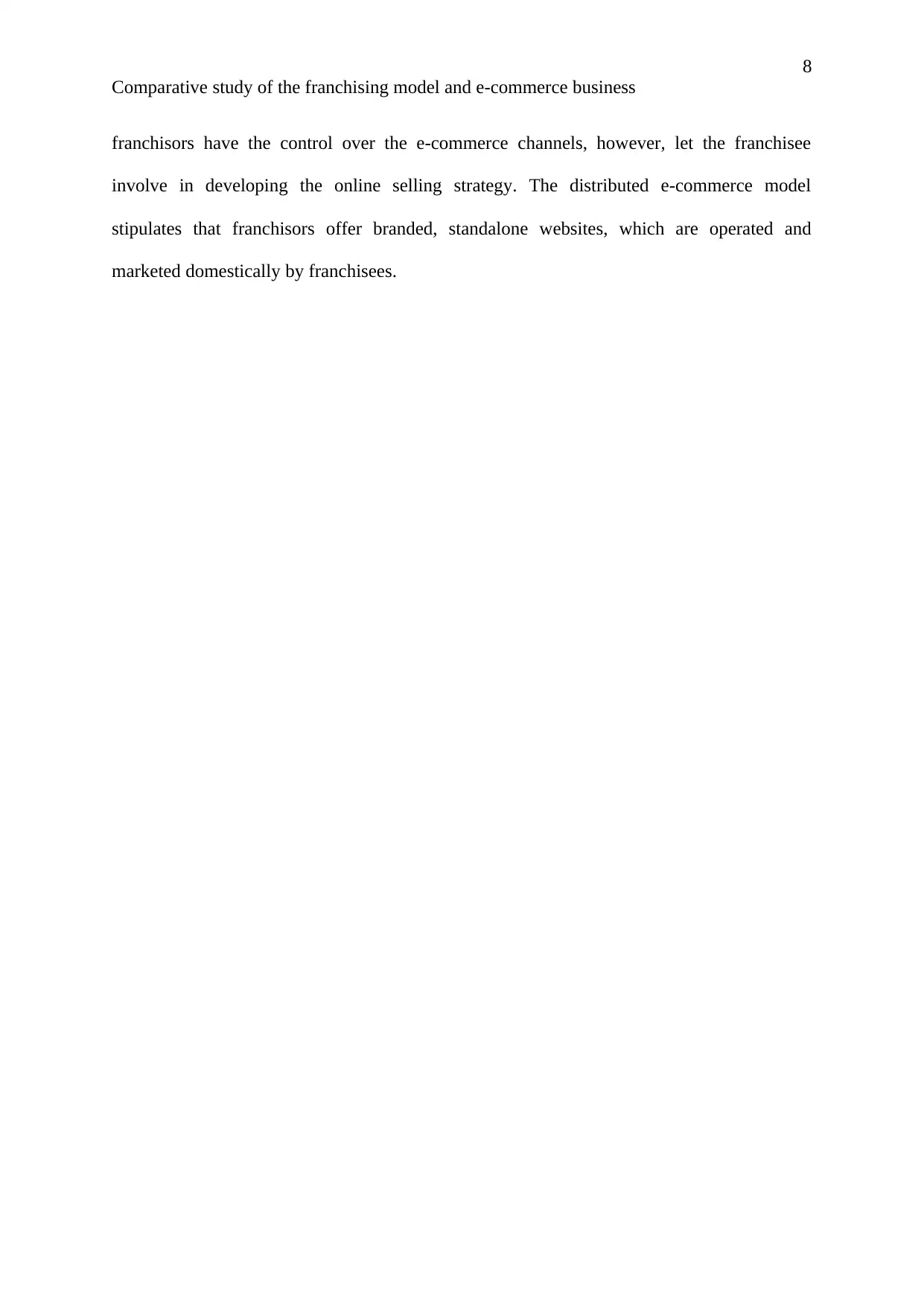
8
Comparative study of the franchising model and e-commerce business
franchisors have the control over the e-commerce channels, however, let the franchisee
involve in developing the online selling strategy. The distributed e-commerce model
stipulates that franchisors offer branded, standalone websites, which are operated and
marketed domestically by franchisees.
Comparative study of the franchising model and e-commerce business
franchisors have the control over the e-commerce channels, however, let the franchisee
involve in developing the online selling strategy. The distributed e-commerce model
stipulates that franchisors offer branded, standalone websites, which are operated and
marketed domestically by franchisees.
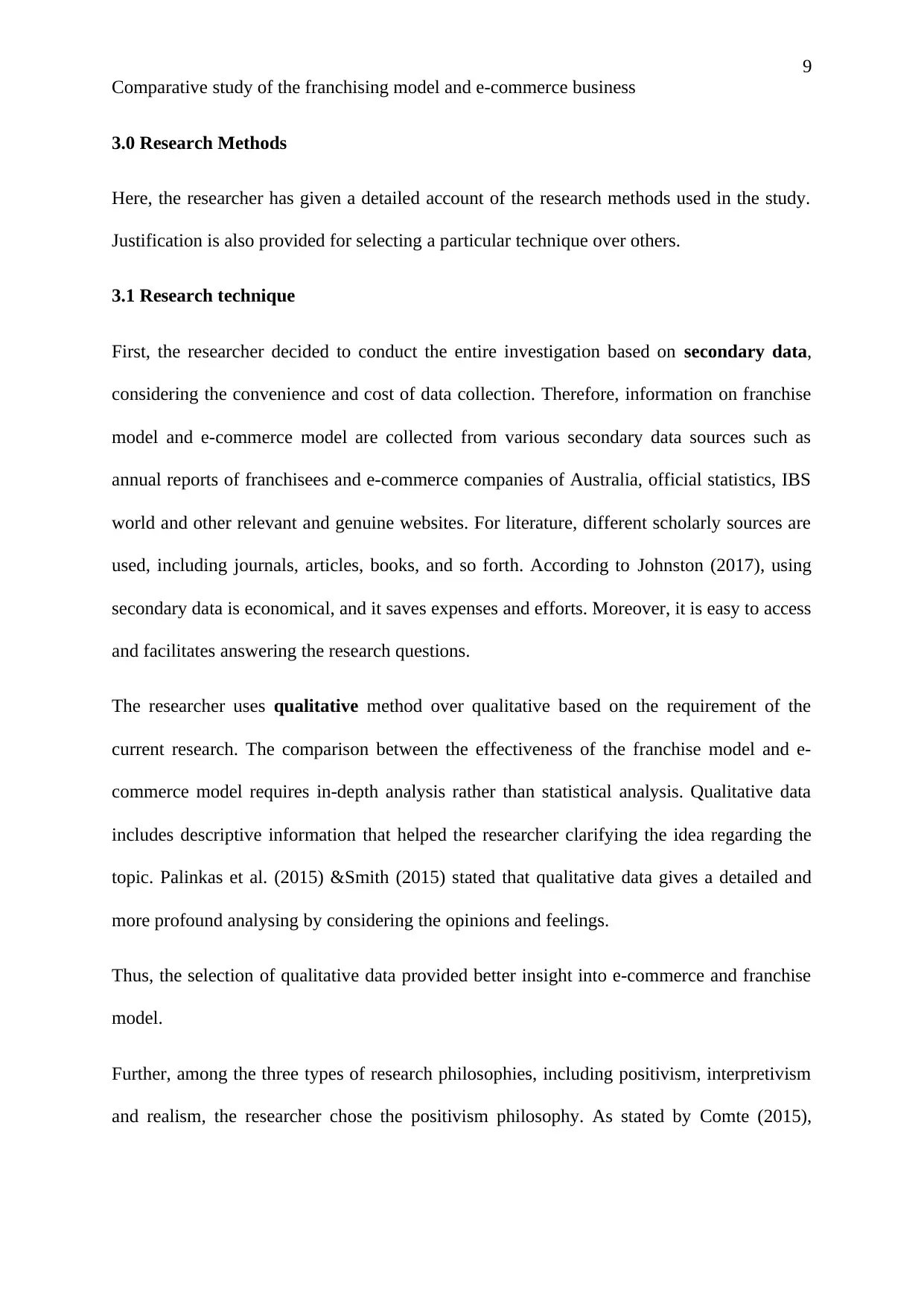
9
Comparative study of the franchising model and e-commerce business
3.0 Research Methods
Here, the researcher has given a detailed account of the research methods used in the study.
Justification is also provided for selecting a particular technique over others.
3.1 Research technique
First, the researcher decided to conduct the entire investigation based on secondary data,
considering the convenience and cost of data collection. Therefore, information on franchise
model and e-commerce model are collected from various secondary data sources such as
annual reports of franchisees and e-commerce companies of Australia, official statistics, IBS
world and other relevant and genuine websites. For literature, different scholarly sources are
used, including journals, articles, books, and so forth. According to Johnston (2017), using
secondary data is economical, and it saves expenses and efforts. Moreover, it is easy to access
and facilitates answering the research questions.
The researcher uses qualitative method over qualitative based on the requirement of the
current research. The comparison between the effectiveness of the franchise model and e-
commerce model requires in-depth analysis rather than statistical analysis. Qualitative data
includes descriptive information that helped the researcher clarifying the idea regarding the
topic. Palinkas et al. (2015) &Smith (2015) stated that qualitative data gives a detailed and
more profound analysing by considering the opinions and feelings.
Thus, the selection of qualitative data provided better insight into e-commerce and franchise
model.
Further, among the three types of research philosophies, including positivism, interpretivism
and realism, the researcher chose the positivism philosophy. As stated by Comte (2015),
Comparative study of the franchising model and e-commerce business
3.0 Research Methods
Here, the researcher has given a detailed account of the research methods used in the study.
Justification is also provided for selecting a particular technique over others.
3.1 Research technique
First, the researcher decided to conduct the entire investigation based on secondary data,
considering the convenience and cost of data collection. Therefore, information on franchise
model and e-commerce model are collected from various secondary data sources such as
annual reports of franchisees and e-commerce companies of Australia, official statistics, IBS
world and other relevant and genuine websites. For literature, different scholarly sources are
used, including journals, articles, books, and so forth. According to Johnston (2017), using
secondary data is economical, and it saves expenses and efforts. Moreover, it is easy to access
and facilitates answering the research questions.
The researcher uses qualitative method over qualitative based on the requirement of the
current research. The comparison between the effectiveness of the franchise model and e-
commerce model requires in-depth analysis rather than statistical analysis. Qualitative data
includes descriptive information that helped the researcher clarifying the idea regarding the
topic. Palinkas et al. (2015) &Smith (2015) stated that qualitative data gives a detailed and
more profound analysing by considering the opinions and feelings.
Thus, the selection of qualitative data provided better insight into e-commerce and franchise
model.
Further, among the three types of research philosophies, including positivism, interpretivism
and realism, the researcher chose the positivism philosophy. As stated by Comte (2015),
⊘ This is a preview!⊘
Do you want full access?
Subscribe today to unlock all pages.

Trusted by 1+ million students worldwide
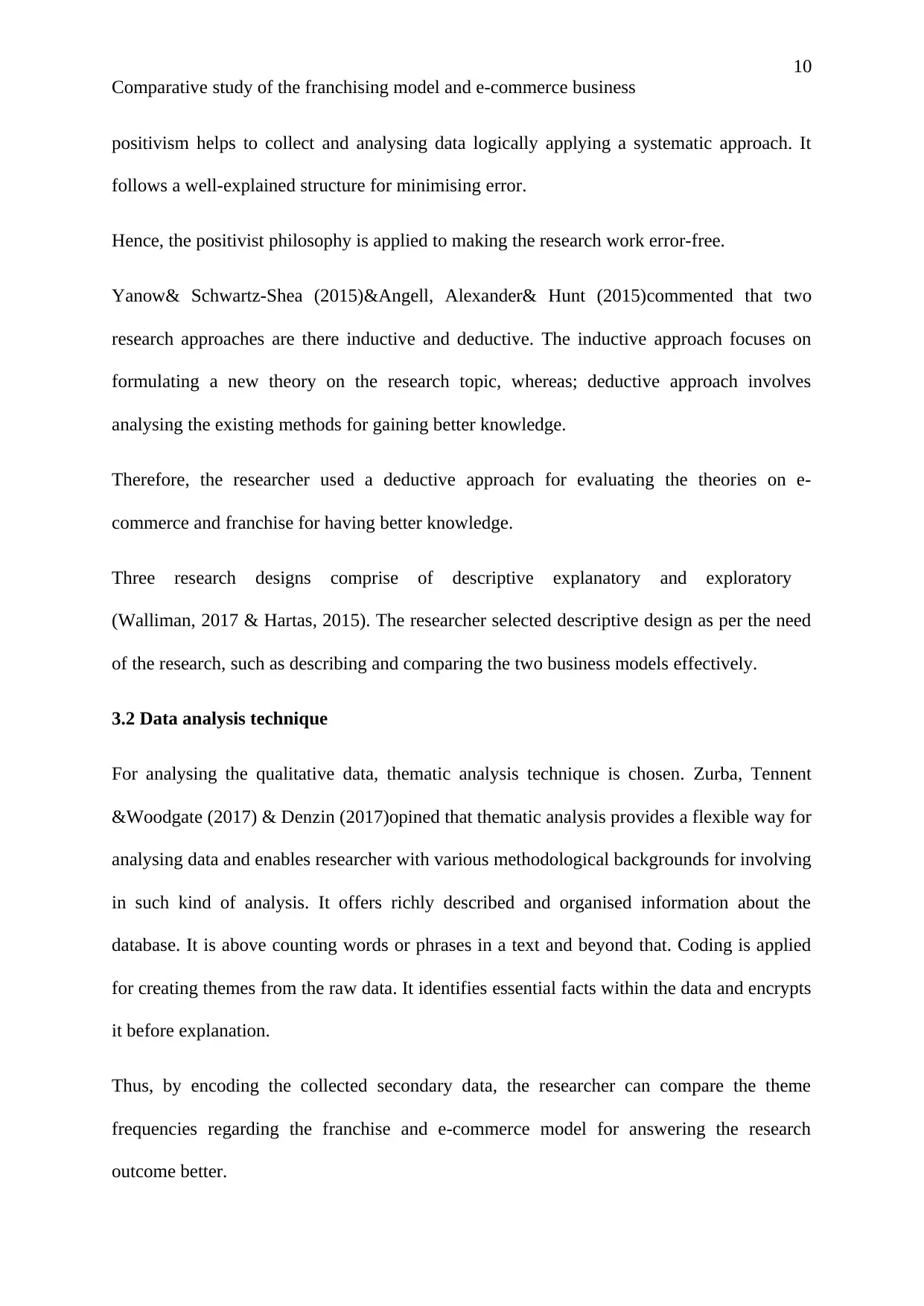
10
Comparative study of the franchising model and e-commerce business
positivism helps to collect and analysing data logically applying a systematic approach. It
follows a well-explained structure for minimising error.
Hence, the positivist philosophy is applied to making the research work error-free.
Yanow& Schwartz-Shea (2015)&Angell, Alexander& Hunt (2015)commented that two
research approaches are there inductive and deductive. The inductive approach focuses on
formulating a new theory on the research topic, whereas; deductive approach involves
analysing the existing methods for gaining better knowledge.
Therefore, the researcher used a deductive approach for evaluating the theories on e-
commerce and franchise for having better knowledge.
Three research designs comprise of descriptive explanatory and exploratory
(Walliman, 2017 & Hartas, 2015). The researcher selected descriptive design as per the need
of the research, such as describing and comparing the two business models effectively.
3.2 Data analysis technique
For analysing the qualitative data, thematic analysis technique is chosen. Zurba, Tennent
&Woodgate (2017) & Denzin (2017)opined that thematic analysis provides a flexible way for
analysing data and enables researcher with various methodological backgrounds for involving
in such kind of analysis. It offers richly described and organised information about the
database. It is above counting words or phrases in a text and beyond that. Coding is applied
for creating themes from the raw data. It identifies essential facts within the data and encrypts
it before explanation.
Thus, by encoding the collected secondary data, the researcher can compare the theme
frequencies regarding the franchise and e-commerce model for answering the research
outcome better.
Comparative study of the franchising model and e-commerce business
positivism helps to collect and analysing data logically applying a systematic approach. It
follows a well-explained structure for minimising error.
Hence, the positivist philosophy is applied to making the research work error-free.
Yanow& Schwartz-Shea (2015)&Angell, Alexander& Hunt (2015)commented that two
research approaches are there inductive and deductive. The inductive approach focuses on
formulating a new theory on the research topic, whereas; deductive approach involves
analysing the existing methods for gaining better knowledge.
Therefore, the researcher used a deductive approach for evaluating the theories on e-
commerce and franchise for having better knowledge.
Three research designs comprise of descriptive explanatory and exploratory
(Walliman, 2017 & Hartas, 2015). The researcher selected descriptive design as per the need
of the research, such as describing and comparing the two business models effectively.
3.2 Data analysis technique
For analysing the qualitative data, thematic analysis technique is chosen. Zurba, Tennent
&Woodgate (2017) & Denzin (2017)opined that thematic analysis provides a flexible way for
analysing data and enables researcher with various methodological backgrounds for involving
in such kind of analysis. It offers richly described and organised information about the
database. It is above counting words or phrases in a text and beyond that. Coding is applied
for creating themes from the raw data. It identifies essential facts within the data and encrypts
it before explanation.
Thus, by encoding the collected secondary data, the researcher can compare the theme
frequencies regarding the franchise and e-commerce model for answering the research
outcome better.
Paraphrase This Document
Need a fresh take? Get an instant paraphrase of this document with our AI Paraphraser
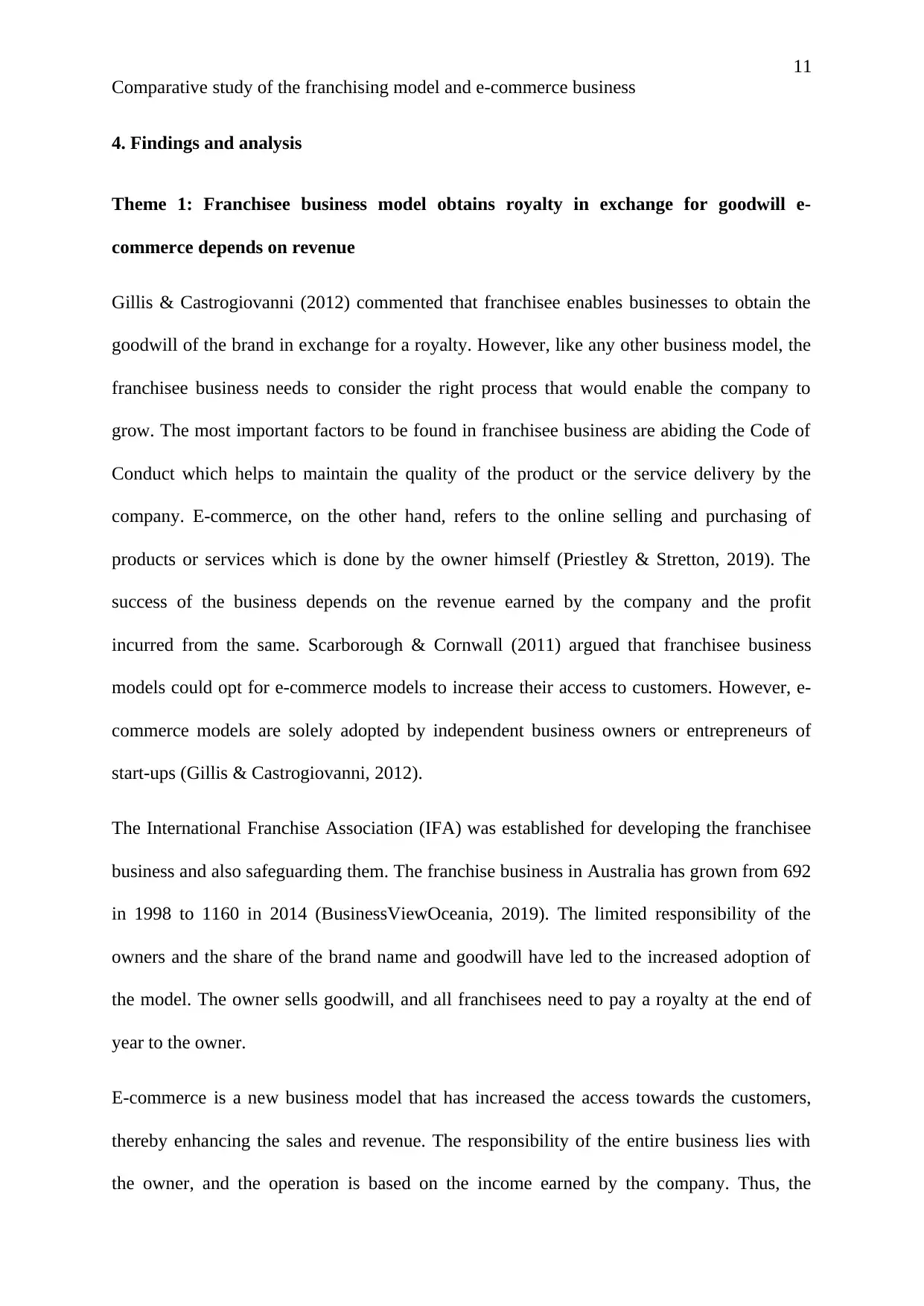
11
Comparative study of the franchising model and e-commerce business
4. Findings and analysis
Theme 1: Franchisee business model obtains royalty in exchange for goodwill e-
commerce depends on revenue
Gillis & Castrogiovanni (2012) commented that franchisee enables businesses to obtain the
goodwill of the brand in exchange for a royalty. However, like any other business model, the
franchisee business needs to consider the right process that would enable the company to
grow. The most important factors to be found in franchisee business are abiding the Code of
Conduct which helps to maintain the quality of the product or the service delivery by the
company. E-commerce, on the other hand, refers to the online selling and purchasing of
products or services which is done by the owner himself (Priestley & Stretton, 2019). The
success of the business depends on the revenue earned by the company and the profit
incurred from the same. Scarborough & Cornwall (2011) argued that franchisee business
models could opt for e-commerce models to increase their access to customers. However, e-
commerce models are solely adopted by independent business owners or entrepreneurs of
start-ups (Gillis & Castrogiovanni, 2012).
The International Franchise Association (IFA) was established for developing the franchisee
business and also safeguarding them. The franchise business in Australia has grown from 692
in 1998 to 1160 in 2014 (BusinessViewOceania, 2019). The limited responsibility of the
owners and the share of the brand name and goodwill have led to the increased adoption of
the model. The owner sells goodwill, and all franchisees need to pay a royalty at the end of
year to the owner.
E-commerce is a new business model that has increased the access towards the customers,
thereby enhancing the sales and revenue. The responsibility of the entire business lies with
the owner, and the operation is based on the income earned by the company. Thus, the
Comparative study of the franchising model and e-commerce business
4. Findings and analysis
Theme 1: Franchisee business model obtains royalty in exchange for goodwill e-
commerce depends on revenue
Gillis & Castrogiovanni (2012) commented that franchisee enables businesses to obtain the
goodwill of the brand in exchange for a royalty. However, like any other business model, the
franchisee business needs to consider the right process that would enable the company to
grow. The most important factors to be found in franchisee business are abiding the Code of
Conduct which helps to maintain the quality of the product or the service delivery by the
company. E-commerce, on the other hand, refers to the online selling and purchasing of
products or services which is done by the owner himself (Priestley & Stretton, 2019). The
success of the business depends on the revenue earned by the company and the profit
incurred from the same. Scarborough & Cornwall (2011) argued that franchisee business
models could opt for e-commerce models to increase their access to customers. However, e-
commerce models are solely adopted by independent business owners or entrepreneurs of
start-ups (Gillis & Castrogiovanni, 2012).
The International Franchise Association (IFA) was established for developing the franchisee
business and also safeguarding them. The franchise business in Australia has grown from 692
in 1998 to 1160 in 2014 (BusinessViewOceania, 2019). The limited responsibility of the
owners and the share of the brand name and goodwill have led to the increased adoption of
the model. The owner sells goodwill, and all franchisees need to pay a royalty at the end of
year to the owner.
E-commerce is a new business model that has increased the access towards the customers,
thereby enhancing the sales and revenue. The responsibility of the entire business lies with
the owner, and the operation is based on the income earned by the company. Thus, the
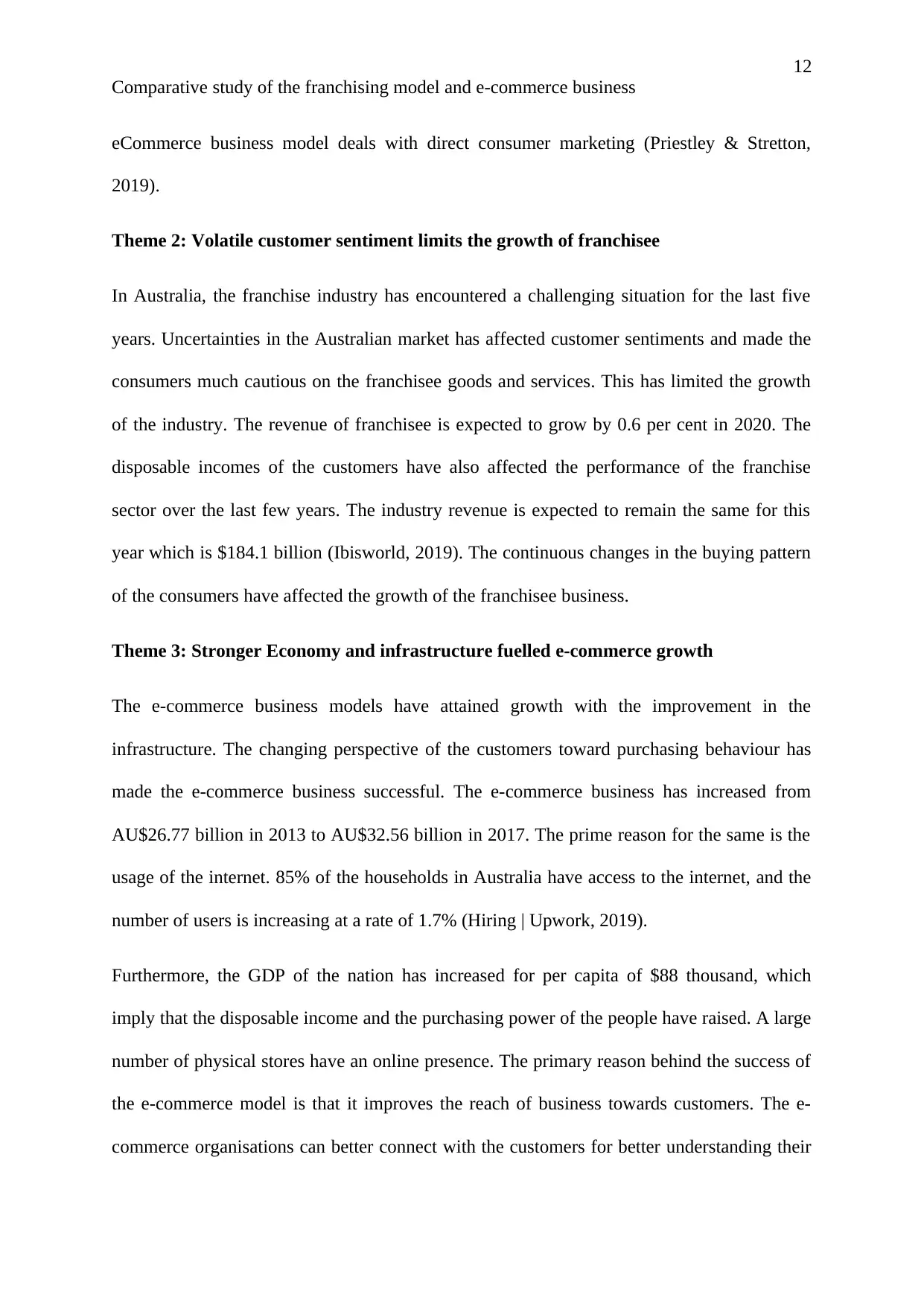
12
Comparative study of the franchising model and e-commerce business
eCommerce business model deals with direct consumer marketing (Priestley & Stretton,
2019).
Theme 2: Volatile customer sentiment limits the growth of franchisee
In Australia, the franchise industry has encountered a challenging situation for the last five
years. Uncertainties in the Australian market has affected customer sentiments and made the
consumers much cautious on the franchisee goods and services. This has limited the growth
of the industry. The revenue of franchisee is expected to grow by 0.6 per cent in 2020. The
disposable incomes of the customers have also affected the performance of the franchise
sector over the last few years. The industry revenue is expected to remain the same for this
year which is $184.1 billion (Ibisworld, 2019). The continuous changes in the buying pattern
of the consumers have affected the growth of the franchisee business.
Theme 3: Stronger Economy and infrastructure fuelled e-commerce growth
The e-commerce business models have attained growth with the improvement in the
infrastructure. The changing perspective of the customers toward purchasing behaviour has
made the e-commerce business successful. The e-commerce business has increased from
AU$26.77 billion in 2013 to AU$32.56 billion in 2017. The prime reason for the same is the
usage of the internet. 85% of the households in Australia have access to the internet, and the
number of users is increasing at a rate of 1.7% (Hiring | Upwork, 2019).
Furthermore, the GDP of the nation has increased for per capita of $88 thousand, which
imply that the disposable income and the purchasing power of the people have raised. A large
number of physical stores have an online presence. The primary reason behind the success of
the e-commerce model is that it improves the reach of business towards customers. The e-
commerce organisations can better connect with the customers for better understanding their
Comparative study of the franchising model and e-commerce business
eCommerce business model deals with direct consumer marketing (Priestley & Stretton,
2019).
Theme 2: Volatile customer sentiment limits the growth of franchisee
In Australia, the franchise industry has encountered a challenging situation for the last five
years. Uncertainties in the Australian market has affected customer sentiments and made the
consumers much cautious on the franchisee goods and services. This has limited the growth
of the industry. The revenue of franchisee is expected to grow by 0.6 per cent in 2020. The
disposable incomes of the customers have also affected the performance of the franchise
sector over the last few years. The industry revenue is expected to remain the same for this
year which is $184.1 billion (Ibisworld, 2019). The continuous changes in the buying pattern
of the consumers have affected the growth of the franchisee business.
Theme 3: Stronger Economy and infrastructure fuelled e-commerce growth
The e-commerce business models have attained growth with the improvement in the
infrastructure. The changing perspective of the customers toward purchasing behaviour has
made the e-commerce business successful. The e-commerce business has increased from
AU$26.77 billion in 2013 to AU$32.56 billion in 2017. The prime reason for the same is the
usage of the internet. 85% of the households in Australia have access to the internet, and the
number of users is increasing at a rate of 1.7% (Hiring | Upwork, 2019).
Furthermore, the GDP of the nation has increased for per capita of $88 thousand, which
imply that the disposable income and the purchasing power of the people have raised. A large
number of physical stores have an online presence. The primary reason behind the success of
the e-commerce model is that it improves the reach of business towards customers. The e-
commerce organisations can better connect with the customers for better understanding their
⊘ This is a preview!⊘
Do you want full access?
Subscribe today to unlock all pages.

Trusted by 1+ million students worldwide
1 out of 25
Related Documents
Your All-in-One AI-Powered Toolkit for Academic Success.
+13062052269
info@desklib.com
Available 24*7 on WhatsApp / Email
![[object Object]](/_next/static/media/star-bottom.7253800d.svg)
Unlock your academic potential
Copyright © 2020–2025 A2Z Services. All Rights Reserved. Developed and managed by ZUCOL.





